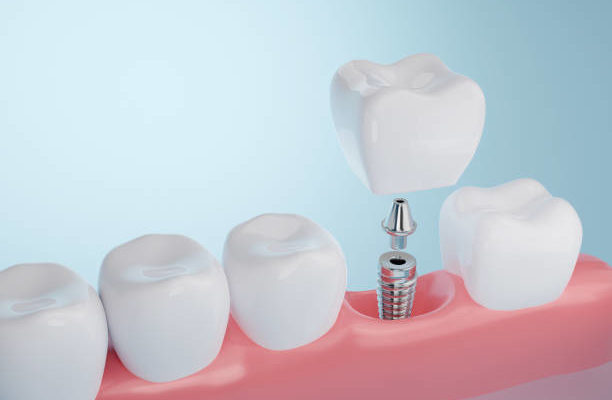
A dental implant is an artificial root, usually made of titanium or zirconium, used to replace the natural root of a lost tooth. It is surgically inserted into the jawbone, then topped with a fixed or removable denture to restore the patient's dentition.
The different parts of a dental implant
A dental implant generally consists of three components:
- The screw: this is the part that is inserted into the bone and supports the implant. It is generally made of titanium or zirconium, biocompatible materials that promote osseointegration.
- The abutment: this part, also known as a connector, connects the screw to the dental prosthesis. It can be made of titanium, zirconium or ceramic.
- The crown: this is the visible part, resembling a natural tooth. Manufacturers use resistant, aesthetic materials such as ceramic or composite.
The different stages of dental implant placement
Installing a dental implant generally involves several steps, spread over several months:
- Consultation and diagnosis: during an initial appointment, the practitioner assesses the patient's oral condition, takes x-rays and discusses possible treatment options.
- Treatment planning: if the practitioner considers an implant to be the best solution for the patient, a treatment plan is drawn up, including dates for surgery and healing times.
- Surgical procedure Under local or general anaesthetic, the practitioner makes an incision in the gum, then drills a hole in the jawbone to insert the screw. The practitioner then closes the gum with stitches.
- Osseointegration: this is the process by which the implant integrates with the bone. This stage, crucial to the implant's stability and longevity, generally lasts between 2 and 6 months.
- Placement of abutment and crown: once osseointegration is complete, the practitioner reopens the gingiva in a second surgical procedure, places the abutment on the screw and then attaches the crown to restore the dentition.
The advantages of dental implants
There are several advantages to opting for a dental implant:
- Aesthetics: dental implants offer a very natural appearance, giving you a beautiful, discreet smile.
- Functionality: well-integrated with the bone, the implant restores chewing comfort equivalent to that of natural teeth. It is also stable and durable, with a lifespan that can exceed 20 years.
- Preservation of neighboring teeth: unlike other prosthetic solutions, such as dental bridges, the implant does not require trimming or touching healthy adjacent teeth, preserving their integrity.
- Maintaining bone structure: by replacing the root, the implant stimulates alveolar bone and prevents its resorption (reduction in volume).
Contraindications and potential risks
Although dental implant placement is a common practice, professionals do not recommend it for everyone because certain factors can increase the risk of complications, such as :
- Poor oral hygiene: regular maintenance and check-ups with the dentist are essential to prevent infections around the implant.
- General health problems: certain conditions, such as diabetes or osteoporosis, can compromise the implant's integration with the bone, increasing the risk of complications.
- Smoking: smoking has a negative impact on gum healing and increases the risk of osseointegration failure.
In conclusion,dental implants are an effective solution for replacing one or more missing teeth. However, you should consult an oral health professional to discuss the treatment options best suited to your situation.





